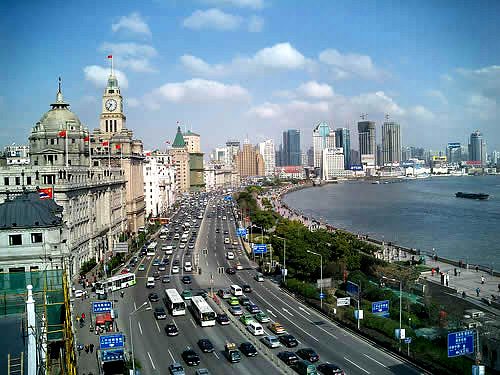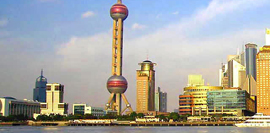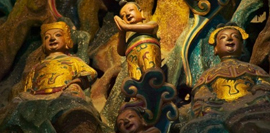The Bund is the best-known landmark in Shanghai. On this stretch of Zhongshan Road East lies the most important buildings left from colonial Shanghai including the Peace Hotel, the Bank of China, and Shanghai Gold Exchange. Externally these buildings have been well preserved and stand proud in their original grandeur. Internally they have been renovated to house some major financial institutions as well as Shanghai's most expensive and luxurious hotels, restaurants and bars.
One of the key features of the Bund is the contrast it provides. On the West side of Zhongshan Road sits the historic European style buildings, the oldest of which is the Jin Jiang hotel built in 1906, this is called 'Puxi' . Just opposite on the Eastern side of the river is the area called 'Pudong' where Shanghai's most modern constructions can be seen. These include the Pearl TV Tower and the Jing Mao Tower. These ultra-modern even space age looking buildings form the most famous view of Pudong's Lu Jia Zui which has come to symbolize Shanghai today.
Both tourists and local Shanghainese alike gravitate towards the Bund as the heart of central Shanghai. Most people come for leisure, yet the Bund is actually home to many of the largest financial institutions of the city, and of China. Though Lujiazui is an important financial center of the city, Zhongshan Road E is considered China's Wall Street. Thus the Bund symbolizes Shanghai's rising star as China's fastest developing city, and is fittingly reminiscent of Shanghai's heyday in the 1930's.
Bund No 3: The Shanghai Club established by English residents in 1861, used to be an important social intercourse place. It was rebuilt in January, 1910 on the site of the old building. 6 Ionic columns were added to the middle part between the second and third story, which created a three-dimensional effect. The Ionic orders, Baroque ceilings and elaborate decorations enhance the artistic beauty and define the building as a representative work of English Renaissance.
Bund No 13: The Customs House was finished in 1927. Its architectural style is a combination of European classicism and modernism. The Greek-style Ionic columns can be easily seen in the front of the main entrance. On top of the building stands a clock tower, designed along the lines of Big Ben in London. It is the biggest clock tower in Asia. At night, the tower is ablaze with light and the hands of clock can be clearly seen from quite a distance away, while the sound travels across kilometers of Shanghai bustle. Now the Customs house is on the list of historic sites under national protection.
Although these classical-style buildings were neither designed by one designer nor constructed during the same period of time, they more or less share the same architectural style. The coordinated outline reflects a sense of luxury and elegance. The architecture on the Bund has been nicknamed a World Architecture Exposition and is considered to be a part of human cultural heritage.






